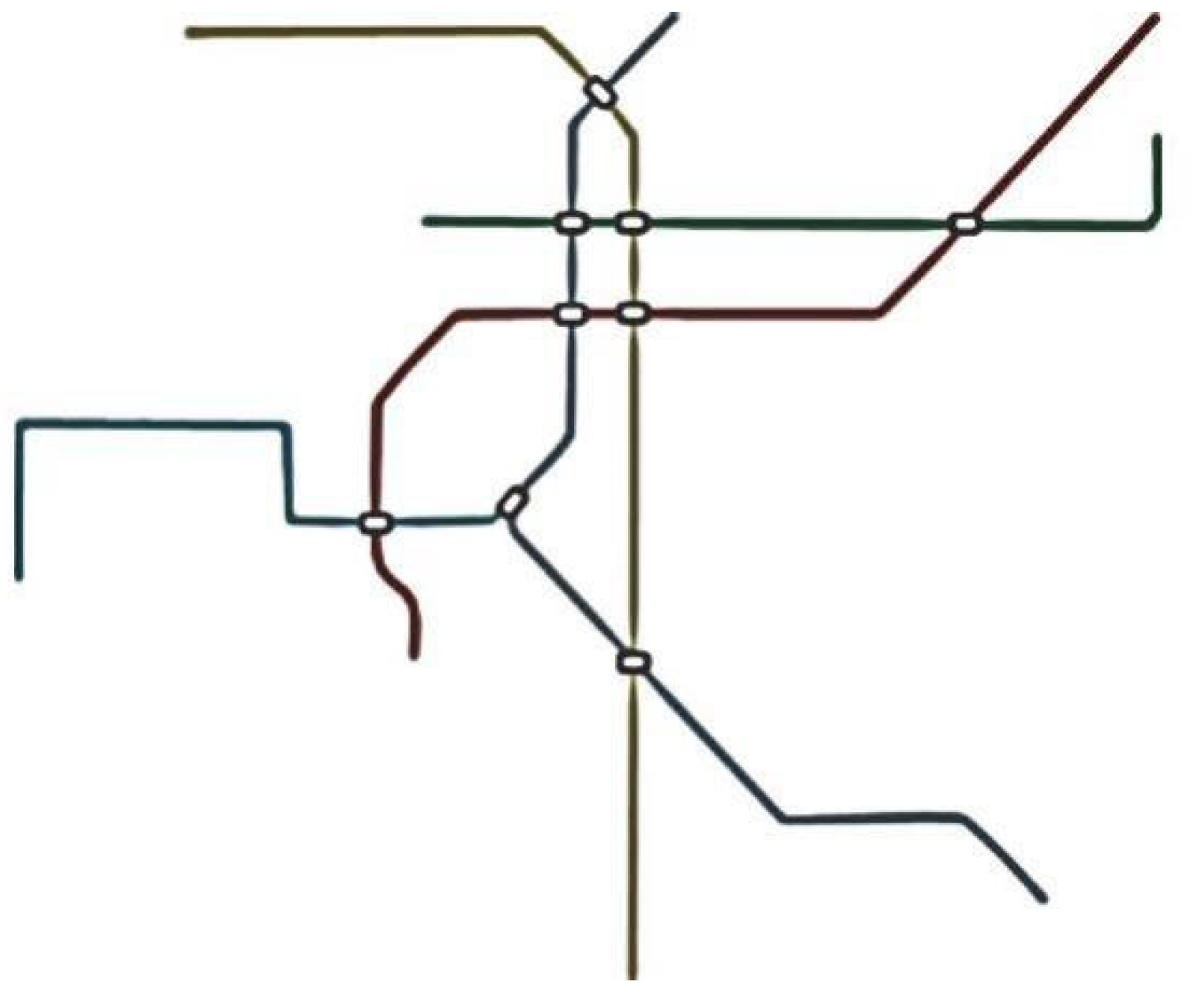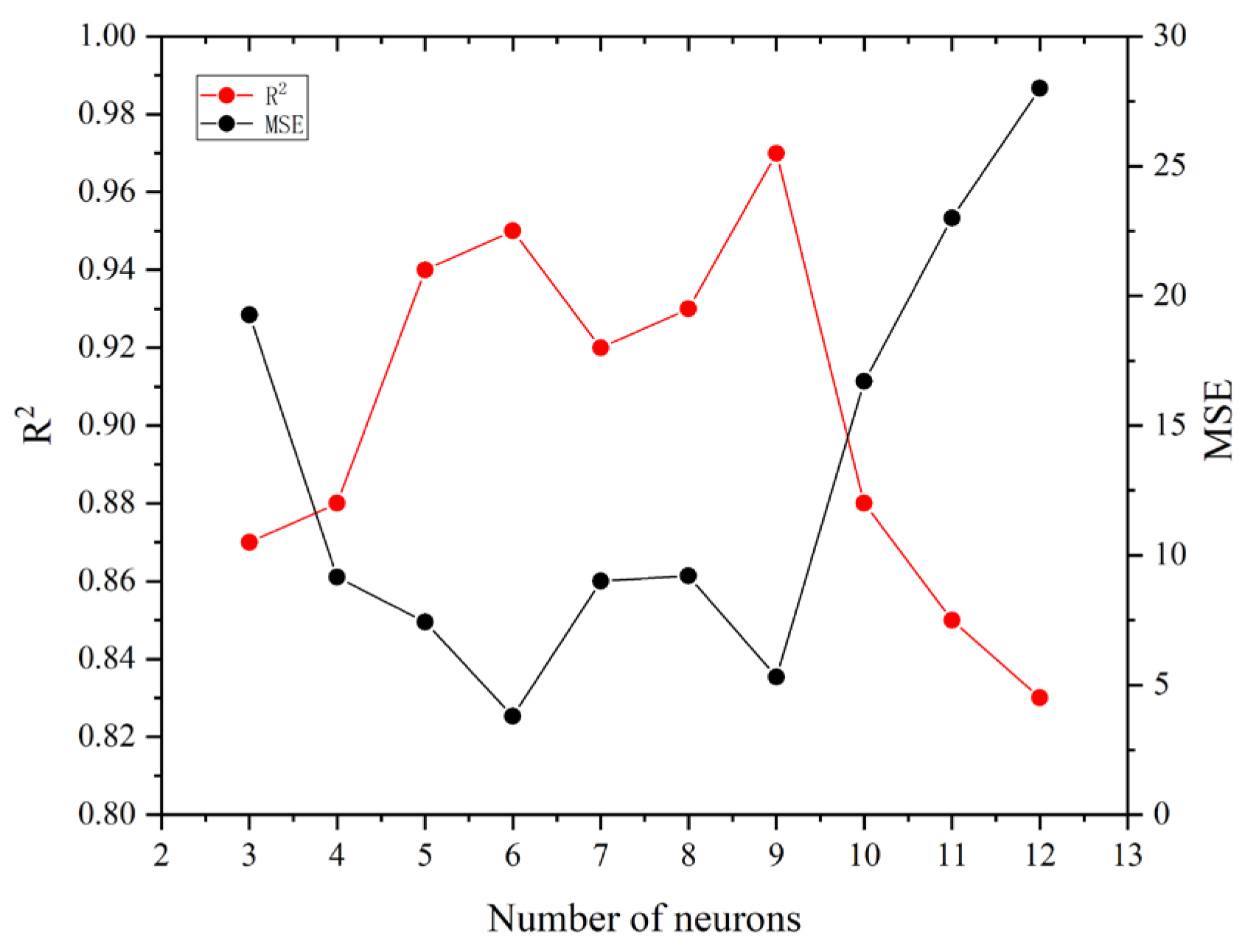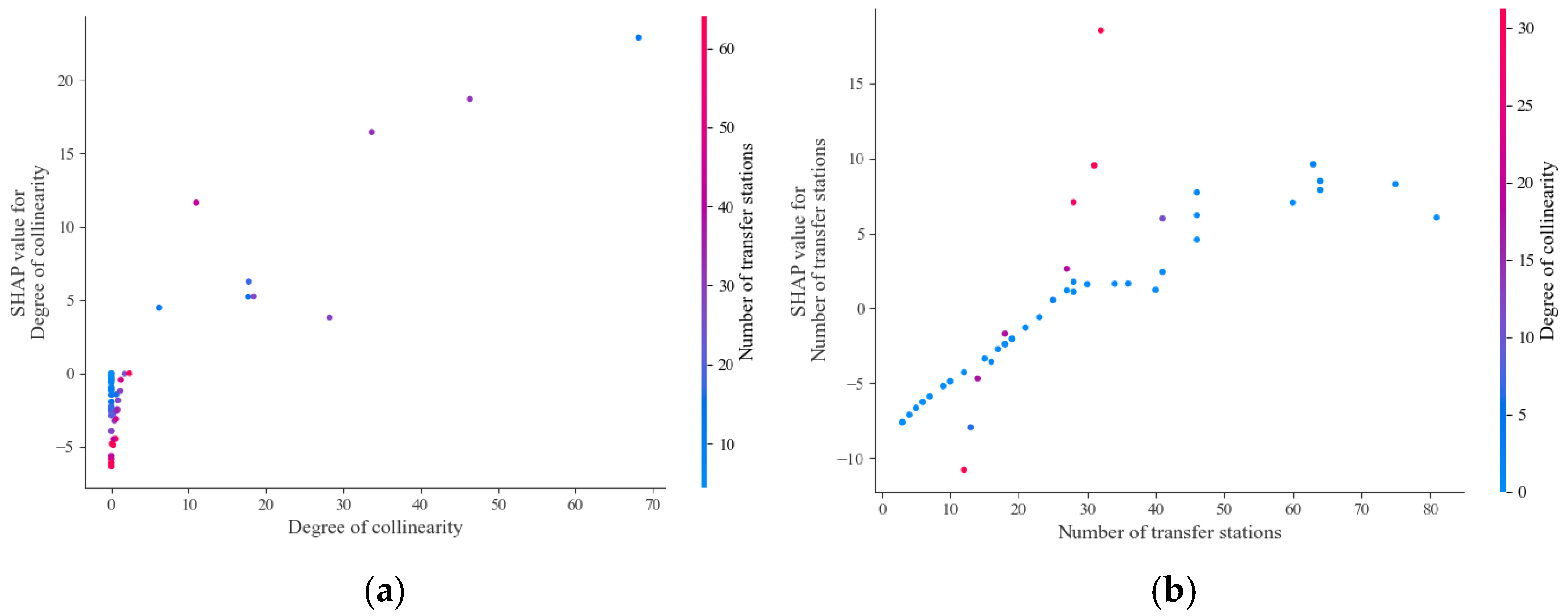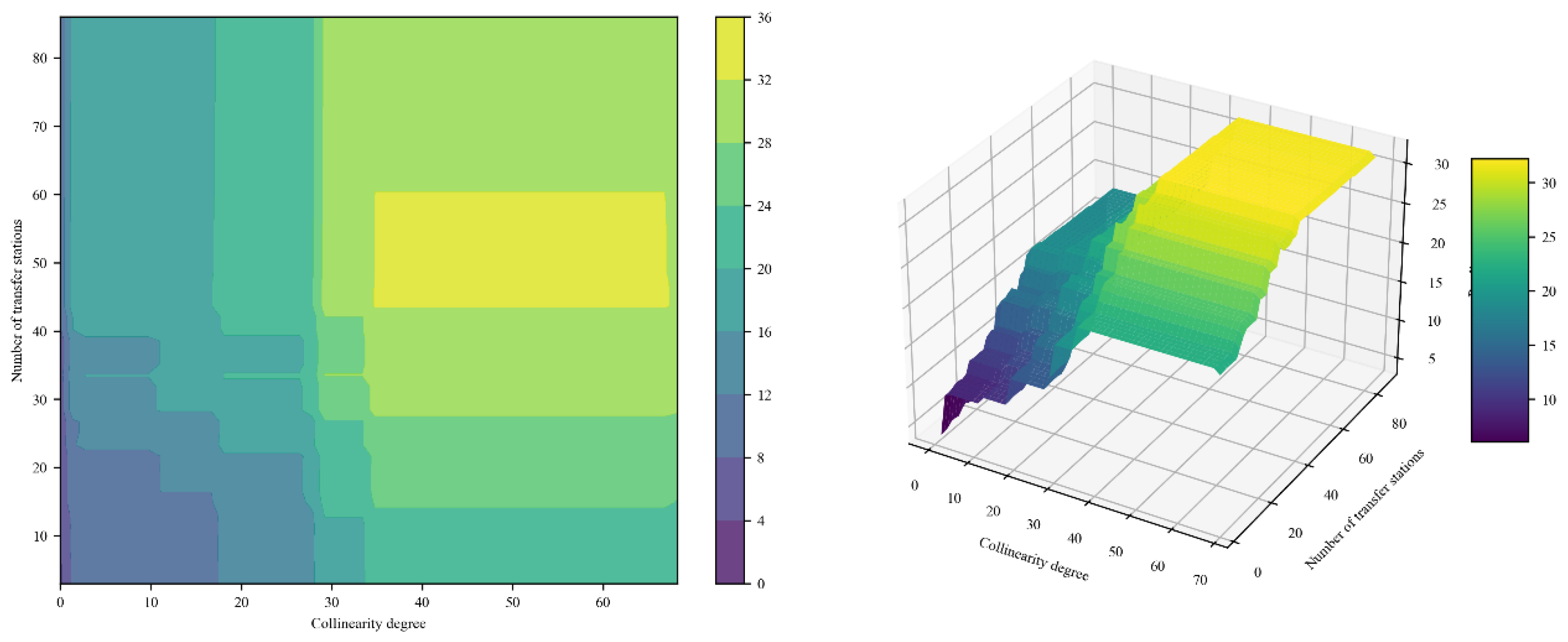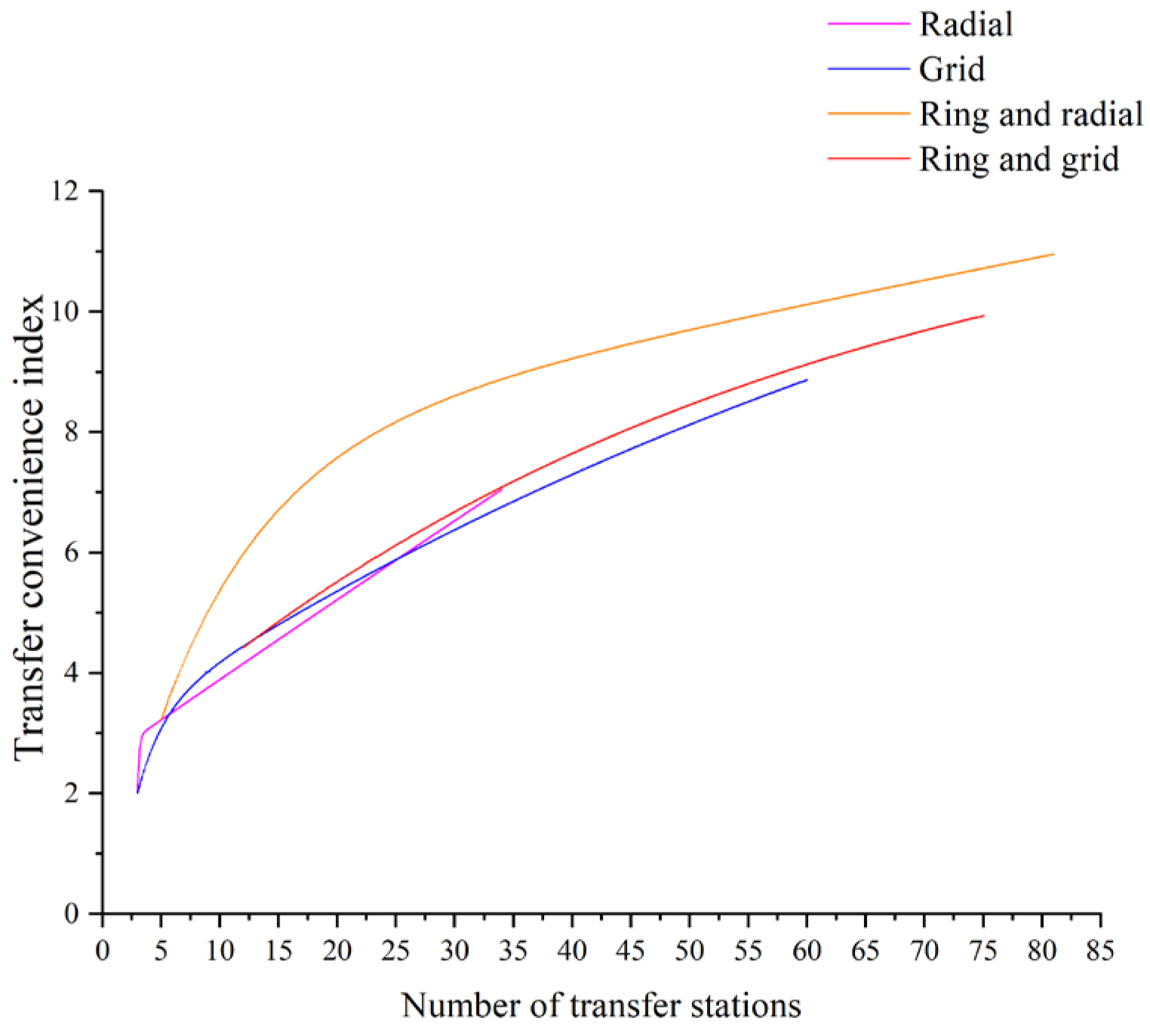1. Introduction
Urban rail transit (URT) is an important mode of transport in modern metropolises, with advantages of safety, economy, environmental friendliness, and punctuality. As a crucial solution to escalating road congestion and environmental pollution, URT’s role is becoming increasingly significant [
1,
2,
3]. By the end of 2024, URT systems were operational in 562 cities in 79 countries around the world [
4]. In China, for example, as of 31 December 2024, 290 URT lines have been operating in 58 cities in China, with a total operating mileage of 12,160 km, and the URT systems in cities such as Beijing, Shanghai, Guangzhou, and Shenzhen have entered into networked operation.
Transfer is prevalent during passengers’ use of URT, and networked operations are often accompanied by an increase in the number of transfers and transfer flows [
5,
6,
7]. For example, in the City of London rail network in the United Kingdom, about 44% of trips on weekdays have at least one transfer, of which 87% have one transfer and 12% have two transfers [
8]. In the Beijing Metro network in China, more than 40 percent of passengers experience a transfer activity during their journey. Most transfers are quite complex due to the complexity of the infrastructure at the transfer stations and the large ridership. A survey in Shanghai, China, showed that when passengers traveled in the metro system, about 50% of their travel time was usually taken up by the transfer process [
9]. Therefore, inconvenient transfers in URT networks may affect their service levels and reduce passenger satisfaction, thus affecting the use of the URT by passengers in their choice of travel mode [
10,
11].
Due to the diversity of natural geological conditions, geographical patterns, land use planning, and passenger flow distribution, the forms of URT networks vary across cities. This variation results in differences in the layout of URT lines, stations, and transfer stations, as well as in the network’s functions and operational efficiency. Based on theoretical frameworks for classifying urban rail transit network morphologies, scholars have identified up to 18 different structural types [
12]. Research on network structures often employs graph-theoretic indicators to define three fundamental types: radial, grid, and ring–radial [
13,
14]. Complex network theory provides a quantitative basis for morphological classification from a topological perspective, validating the rationality of this structural categorization [
15,
16].
Through a geometric decomposition into radial, grid, and ring units [
17], this study identifies four core network morphologies—radial, grid, ring–radial, and ring–grid, as illustrated in
Figure 1. These four morphologies encompass the representative skeletal structures of mature global URT networks, ensuring comparability in transfer convenience [
18,
19].
In addition, the form of the line is also differentiated between intersecting form and colinear form [
20,
21], all of which will have an impact on the transfer convenience of the URT network. Studies have found that these two forms as distinct clusters with statistically significant differences, such as the ratio of transfer stations to lines [
22]. The intersecting form is characterized by discrete transfer nodes, whereas the colinear form features continuous shared corridors, capturing fundamental differences in line operation and passenger transfer experience.
As shown in
Figure 2, the basic feature of the intersecting form is that two rail lines are separated from each other at transfer stations. Two lines with a transfer relationship usually have one or more public transfer stations, which are often not continuous [
23]. URT networks achieve relatively high network coverage with fewer lines, which facilitates rapid expansion of the network to cover major passenger corridors.
As shown in
Figure 3, the basic characteristic of a colinear form is that two rail lines use parallel or shared tracks at transfer stations, where passengers transfer to the other line in the same or opposite direction at the same platform, and there are usually continuously available transfer stations along the line. Cities with this network form usually have a unique urban form and history. At the same time, not every line operates on a common line or common track [
24]. During the construction and development of a colinear form network, a combination of colinear and intersection forms can be used to expand the network.
Existing studies have demonstrated that collinearity in transit networks significantly affects transfer performance and system efficiency. Fan and Machemehl [
25] showed that collinearity between routes influences passenger waiting behavior and transfer choices, thereby altering perceived accessibility. Derrible and Kennedy [
26] found that excessive collinearity in global metro systems undermines network resilience and operational efficiency. Cats [
27] analyzed the Stockholm metro, highlighting that collinear sections reshaped transfer opportunities and reduced system robustness. Jiang et al. [
28] quantified navigation complexity in large-scale transit systems and revealed that higher collinearity increases passengers’ cognitive burden, thus lowering transfer convenience.
Recent research has further emphasized route diversity and redundancy as critical dimensions of network performance. For example, Wang et al. [
29] integrated route diversity and spare capacity to assess redundancy, while Li et al. [
30] developed methods to evaluate route diversity by explicitly considering collinear segments of transit lines. Dixit [
31] investigated the perception of collinearity in multimodal networks, showing that passengers often perceive highly collinear lines as functionally equivalent, which diminishes the effective benefits of multiple routes. In addition, resilience-oriented studies demonstrate that collinearity interacts with redundancy in shaping system continuity under disruptions [
32].
Although scholars have conducted extensive research on transfers in URT, there is limited literature on the impact of URT network topology on transfer convenience. However, the URT network topology can determine the number of passenger transfers required during a journey, and frequent transfers can directly affect the traveling experience of passengers. In addition, URT systems are primarily located underground (i.e., part of an above-ground station) in the city. It is difficult to change the network structure after construction. Therefore, it is necessary to fully consider the difference in network morphology in transfer capacity in the planning stage, and rationally select network morphology and operation mode to minimize the number of transfers and improve the transfer convenience.
In order to solve the above problems, this paper selects fifty URT networks in the world according to four network morphologies, extracts the transfer convenience indexes, and investigates the nonlinear effects of their influencing factors based on a back propagation neural network and SHapley Additive exPlanations algorithm. The main contributions of this paper are as follows:
- (1)
A transfer convenience index was used to characterize the transfer convenience in terms of the topology of the URT network.
- (2)
The relative importance and nonlinear effects of network topology parameters on the impact of transfer convenience are analyzed.
- (3)
Reveals the changing rules of transfer convenience under different network morphologies.
The remainder of the paper is organized as follows:
Section 2 reviews previous studies on the subject.
Section 3 describes the modeling methodology used, as well as the calculation of the collinearity degree and the transfer convenience index. In
Section 4, we present and analyze the relationship between transfer convenience and network topology by investigating fifty URT systems around the world. Finally,
Section 5 gives the main conclusions.
4. Results and Discussion
4.1. Modeling Adjustments
The layers of the neural network model are connected to each other through different types of excitation functions, where the input layer is connected to the hidden layer through a log-sigmoid function, the purelin function is selected between the hidden layer and the output layer, and the training function is selected as the trainlm function.
The BPNN model used in this study is a 3-layer structure, in which the input layer is 5 neuron nodes, representing
X1,
X2,
X3,
X4,
X5, respectively, and the output layer is 1 neuron node, which represents the transfer convenience index. Generally speaking, setting up more than one implicit layer will increase the algorithmic complexity, prolong the training time, and have little effect on improving the accuracy; therefore, the study used a single hidden layer. According to the empirical formula to determine the approximate range of the number of nodes in the implied layer [
3,
12], after many tests, as shown in
Figure 4, the model achieved the lowest MSE (the mean square error) and a high
R2 value when the number of neurons in the implied layer was set to 9, indicating optimal predictive accuracy without overfitting. Therefore, the number of neuron nodes was determined to be 9 in further analyses.
4.2. Model Comparison
To test the robustness of the model, a comparative study was conducted between the operational results of BPNN and other machine learning methods, including Random Forest, Gradient Boosting, LightGBM, and a Graph Neural Network (GNN).
Table 3 illustrates the outcomes. The BPNN model has lower RMSE and MAE values, and its
R2 value is also greater than the other models, indicating better fitting results, and supporting its suitability for capturing the complex nonlinear relationships in our topological dataset.
All analyses were conducted using Python 3.7 with key libraries including TensorFlow (for BPNN), scikit-learn (for comparative models), and PyTorch 1.13.1 (for GNN). A fixed random seed of 42 ensured reproducibility. The BPNN was trained for 100 epochs using the Adam optimizer (learning rate = 0.001). Comparative models were optimized via 5-fold cross-validation, and curve fitting utilized the Levenberg–Marquardt algorithm.
4.3. Relative Importance of Independent Variables
The results of the calculation of the importance of the independent variables to
K are shown in
Table 4. The ranking is based on the value of relative importance, with a sum of 100 percent. It can be seen that
X5 contributes the most to the prediction of the
K, exceeding the sum of the other four variables at 51.94%, followed by
X3 (30.62%), which has a combined importance of more than 80%.
This paper further provides a more refined analysis of the possible influence mechanisms of the independent variables using the SHAP model, which generates a summary plot that ranks the independent variables according to their influence on K. In this plot, the x-axis represents the SHAP value (indicating the impact on the model output), and the color of the data points indicates the value of the independent variable—a redder value signifies that the actual value of the variable is larger within its respective range, such as mileage around 200 to over 800 km, number of transfer stations about 30 to 80, or degree of collinearity around 10% to 70%.
As shown in
Figure 5, the reddest points, which correspond to networks with exceptionally high collinearity, are clustered exclusively in the region of high positive SHAP values. When
X5 is higher, the SHAP value is higher, and there is a strong positive correlation with the
K, and as
X5 decreases, the SHAP value gradually decreases, and there is even a negative correlation with the
K, which shows that there is a threshold effect of
X5 on the
K. This suggests that a collinearity degree exceeding a certain level is a key differentiator for high transfer convenience.
In contrast, the influence of X3 on K is more complicated, and it can be seen that the SHAP value of the number of transfer stations increases and then decreases as the color becomes red. This pattern indicates that beyond a certain scale, merely increasing the number of transfer stations does not uniformly yield higher convenience. Therefore, the X3, X5, and K do not have a simple linear relationship, and more in-depth research is needed. The influence of other factors, such as the mileage and the number of lines, is comparatively lower, as their SHAP values are clustered closer to zero.
To further elucidate the nonlinear influence of the collinearity degree (
X5) identified by the SHAP analysis, a partial dependence plot (PDP) was employed. As can be seen from
Figure 6, the PDP reveals a clear stepwise pattern:
K increases steeply at collinearity thresholds of approximately 2%, 11%, and 18%, with stable plateaus observed between these points. Additionally, the grey bars delineates the density distribution of collinearity degree, with peaks around 0 and 17.5 highlighting the most prevalent levels. This demonstrates the discontinuous nonlinear impact of collinearity on transfer convenience and provides critical insights for staged network design.
4.4. Interaction Between Collinearity Degree and the Number of Transfer Stations
In order to further reveal the mechanism of the influence of the
X3 and
X5 on the
K, we used BPNN and SHAP to obtain the influence of the interaction between the
X3 and
X5 on the
K, as shown in
Figure 7. This interaction is further visualized in the updated
Figure 8 via a heatmap and a 3D surface plot.
X3 and
X5 as the independent variables and
K as the dependent variable were fitted using Poly2D, and the fitting results are shown in Equation (12).
As shown in
Figure 7a, the larger the collinearity degree, the larger the SHAP value, and when
X5 exceeds 10%, the SHAP value is generally greater than 0. Meanwhile,
Figure 7b shows that
X5 can significantly change the influence of
X3 on
K, and the higher the
X5, the higher the SHAP value of
X3. Combined with Equation (13), it can be obtained that for every 1% increase in
X5, the increase in
X3 for
K increases by 0.03 for every increase in
X3. Therefore, in the planning of the line network, especially when the URT network reaches a certain scale and the increase in the number of transfer stations for the increase in
K is already very weak, it can be further improved by adopting the colinear form to improve
K of the URT network. The transfer convenience of the URT network can be further improved by adopting the colinear form.
These interaction patterns are further visualized in
Figure 8. As shown in the heatmap, the influence of the number of transfer stations (
X3) on
K intensifies markedly as
X5 increases. Complementarily, the 3D surface plot directly illustrates how the effect of
X3 is modulated by
X5, showing that the marginal contribution of transfer stations to convenience is elevated within a high-collinearity context.
4.5. Impact of the Number of Transfer Stations on Transfer Convenience
The number of transfer stations is an important factor affecting
K. The more transfer stations there are, the more transfer nodes connecting different lines, the more traveling paths passengers can choose, and the better the transfer convenience. The SHAP analysis revealed that the collinearity degree (
X5) is the most dominant factor influencing
K and exhibits a complex interaction with
X3. To minimize this confounding effect and to better isolate and capture the underlying relationship between
X3 and
K that is not driven by extreme collinearity, 12 cities with large
X5 were excluded from this specific analysis. We used BPNN and an exponential function to fit the functional relationship between the two; the trend is shown in
Figure 7, and the values of the fitted parameters, including the goodness-of-fit measures
R2, Adjusted
R2, MAE, and RMSE, are summarized in
Table 5. These metrics consistently confirm the superior performance of the BPNN model.
The parameter constant (denoted as y0) represents the asymptotic maximum value of K when X3 is very large. The coefficients a1 and a3 indicate the initial deviations from this maximum, while a2 and a4 are decay constants that determine how rapidly K approaches y0 as X3 increases.
As can be seen from
Figure 9, with the increase in
X3, the overall trend of
K is increasing. The
R2 value of the fitting using BPNN is 0.86, which is significantly better than the fitting effect of the exponential function. As shown in
Figure 9a, when
X3 is in the ranges of 0–15, 21–30, 65–75,
K has a significant increase, and there is a long period of stabilization when it is between 30 and 65. As shown in
Figure 9b, with the increase in
X3, the increase in
K slows down, and when
X3 reaches 35 or more, each additional transfer station can only improve
K by 0.1. Therefore, when planning the line network, it is necessary to set up a reasonable number of transfer stations. When the number of transfer stations is less than 30, it is necessary to increase the number of transfer stations to improve the convenience of the URT network. When the number of transfer stations reaches more than 35, it is unwise to blindly increase the number of transfer stations, because this strategy does not sufficiently help to improve the convenience of the URT network. At the same time, we can see that with the increase in
X3, the degree of discrete points gradually increases.
Therefore, to quantitatively investigate this changing relationship, we calculated the Pearson correlation coefficient between
X3 and
K as
X3 increased, along with its 95% confidence bands. As shown in
Figure 10, when
X3 is lower than 15,
K shows a significant correlation with
X3, while the correlation weakens with the increase in
X3. The possible reason for this is that when
X3 is small, the relationship between
K and
X3 is similar under different network morphologies, but with the increase in line density, the network morphologies are basically fixed, which makes the relationship between
K and
X3 more complicated.
It is important to note that the exponential relationship identified between X3 and K is derived from networks with low to moderate collinearity. Consequently, the findings and planning implications may not be directly generalizable to systems with high degrees of collinearity. In such networks, the presence of shared corridors fundamentally alters the transfer dynamics, and the convenience is more significantly enhanced by the collinearity degree itself.
4.6. Impact of Network Morphology on Transfer Convenience
This paper investigates changes in transfer convenience after removing different proportions of the number of nodes from URT networks with different morphologies. To explore general patterns, cities with extensive co-locations were not considered. The nodes with the largest degree play an important role in the network, making the network vulnerable to attacks targeting these nodes with the largest degree. Therefore, in this paper, after removing one node with the largest degree in the network, we calculated the
K of the remaining network once until the
K of the network was 0 and obtained the relationship between the
K and the proportion of removed points under different network morphologies, as shown in
Figure 11.
Figure 11a shows the variation in
K of the radial network, and it can be seen that
K basically shows a linear decrease with the increase in the proportion of removed points. When the proportion of removed points reaches 10%, the
K basically decreases to zero.
Figure 11b shows the change in
K of the grid network. Compared with the radial network, the decreasing trend of
K is slowed down, and the robustness of the network is relatively enhanced. When the proportion of removed points is around 10% versus 18%, the
K basically drops to zero.
Figure 11c shows the variation in
K of the ring–radial network, and the
K is significantly improved compared to the radial network. With the increase in the proportion of removed points, the decrease in
K gradually decreases, and at the same time, the higher the
K, the smaller its decrease, i.e., the more robust the network is. As shown in
Figure 11d, the overall
K of the ring–grid network is higher than that of the grid network, and its variation is similar to that of the grid network.
Through previous exploration, we have found that the exponential function better describes the relationship between the two variables. To further investigate the impact of network morphology on transfer convenience, we used the exponential function to fit the relationship between
K and
X3 in the URT network across different network morphologies. The fitting results are shown in
Figure 10 and
Table 6.
When the relationship between X3 and K is fitted after classifying different network morphologies, the R2 value reaches more than 0.9, which indicates that the network morphology also affects the transfer convenience, and there are different morphologies between X3 and K under different network morphologies. The low MAE and RMSE values further confirm the robustness of these fits. Among them, the R2 of the grid network reaches 0.96, but also low errors, which indicates that the change of the K is the most stable under the grid network morphology. Notably, the ring–grid morphology exhibits the smallest prediction errors, underscoring its structure and the highly predictable relationship between transfer stations and convenience.
Meanwhile,
Figure 12 shows that under the same condition of
X3, the ring–radial network has the largest
K. When
X3 is more than 10, the radial network can significantly improve
K by adding loop lines, while the grid network will only produce certain benefits for the
K when
X3 reaches more than 20. Therefore, in the long-term planning of the URT network, the choice of a ring–radial network can better improve the transfer convenience of the URT network.
5. Conclusions
5.1. Summary and Major Findings
This research delves into the impact of network topology and morphology on transfer convenience in URT systems, shifting the analysis of transfer convenience impacts from the station level to the network level. Through an analysis of 50 global URT networks, our study confirms the hypothesis that network topology and collinearity significantly influence transfer convenience for URT passengers. The study employs regression analysis to elucidate the relationship between the transfer convenience index and network topology. Key conclusions are as follows:
Collinearity degree and the number of transfer stations emerge as pivotal factors influencing URT transfer convenience. The collinearity degree can significantly affect the relationship between the number of transfer stations and the convenience index. Therefore, we suggest that the design of common lines should be reasonably adopted in the construction of URT to improve the transfer convenience of the network.
Excluding collinearity considerations, a nearly exponential relationship is discernible between the transfer convenience index and the number of transfer stations. However, the marginal benefit of adding transfer stations diminishes beyond a certain point, particularly when the number exceeds 35. This finding underscores the need for strategic planning in URT expansion, avoiding indiscriminate increases in transfer stations.
Network morphology also plays a vital role in shaping transfer convenience. When the number of transfer stations is more than 15, the change of transfer convenience in different network morphologies starts to diverge, with the ring–radial configuration demonstrating superior convenience. These findings have a certain significance, and decision-makers should pay more attention to the network morphology when planning and designing the URT network.
5.2. Policy Implications
Beyond the theoretical and empirical findings, this study provides several policy-oriented insights for the planning and management of urban rail transit (URT) systems. These implications are intended to guide decision-making in both established and rapidly developing cities, ensuring that infrastructure investments are not only technically sound but also socially and economically sustainable.
Firstly, for cities with predominantly radial networks, the collinearity degree and the number of transfer stations should guide long-term development strategies. When transfer stations exceed 10, planners should begin preparing for circumferential connections. Policy measures may include reserving land corridors for future ring lines, incorporating ring components in master plans, and prioritizing ring–radial expansion in medium- and long-term investment programs. Institutional coordination between municipal and regional planning agencies is essential to ensure that ring line projects align with population growth and demand forecasts.
Moreover, the diminishing marginal returns of transfer stations beyond 35 highlight the need for investment rationalization. Our analysis shows that while adding transfer stations initially expands passenger route options and significantly improves transfer convenience, the incremental benefit declines once a certain density is reached. Beyond this threshold, additional hubs tend to duplicate existing connections, concentrate flows, and increase operational complexity without yielding proportional gains in accessibility. This implies that investments should not simply target the number of transfer nodes, but rather focus on improving their quality and efficiency. Policymakers are therefore encouraged to apply cost–benefit evaluation frameworks when considering new transfer stations, taking into account projected demand, construction costs, and system-wide effects. Complementary measures—such as expanding the capacity of existing hubs, enhancing wayfinding and guidance systems, or deploying digital solutions like integrated ticketing and smart subsidies—can often deliver greater improvements to passenger experience than building additional stations.
In addition, collinearity should be explicitly considered in network design standards. Moderate collinearity can improve connectivity, but excessive overlap must be avoided. Policy actions can include setting upper thresholds for permissible line overlap during feasibility studies, requiring that environmental and social impact assessments address redundancy risks, and establishing design guidelines that encourage diversification of alignments in new lines. In addition, transport authorities can introduce evaluation tools that quantify passenger cognitive burden and operational vulnerability, ensuring that system efficiency is not undermined by redundant infrastructure.
Finally, the mechanisms identified in this study extend to multimodal systems, which require integrated governance. Policies should encourage coordinated planning between metro, light rail, tram, and bus systems to minimize transfer penalties. Recommended measures include the development of multimodal hubs that physically collocate different modes, synchronized scheduling across operators, unified ticketing and fare capping policies, and real-time multimodal information platforms. Moreover, when planning expansions, scenario-based planning tools should be employed: for example, prioritizing new transfer nodes when station density is low, and restructuring morphology toward ring–radial configurations when density is high. These measures will allow decision-makers to embed resilience and efficiency into multimodal networks.
5.3. Limitations and Future Research
Despite these findings, the study acknowledges its limitations. Firstly, urban rail network morphology is complex due to factors including urban form and land use, and therefore, the four classifications of URT networks used in the study may not describe all network morphology. Employing data-driven methods would enable more nuanced classifications that capture hybrid and evolving network characteristics. Secondly, while the research focused on global network topological parameters, the impact of local network characteristics remains an area for future exploration to aid in more nuanced urban rail network planning and design. Thirdly, the exclusion of high-collinearity networks in the exponential model analysis may affect its generalizability. Additionally, the study’s scope is confined to metro systems and relies on static network maps, which do not capture dynamic operational elements like peak-hour demand or service disruptions. Future research could incorporate more sophisticated modeling techniques and extend the analysis to multimodal systems and dynamic data sources, providing a more unified understanding of these interconnected factors.
Furthermore, the transfer convenience index (K) is based solely on topological features and does not incorporate behavioral or operational factors. Future studies should build upon this topological foundation by integrating multi-dimensional passenger data to develop a more holistic understanding. Specifically, research could focus on (1) correlating topological indices with revealed passenger preferences from smart card data and stated preferences from passenger surveys; (2) investigating how operational factors like waiting time and crowding moderate the relationship between topology and perceived convenience; and (3) exploring how urban morphology interacts with network structure in shaping transfer efficiency. Integrating equity and accessibility perspectives remains a vital dimension for comprehensively evaluating network improvements. Such integrated approaches would bridge the gap between network structure and passenger experience, enabling more comprehensive planning frameworks for urban rail transit systems.

